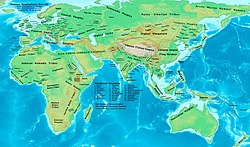Rashtrakuta literature

Rashtrakuta literature (
Kannada writings
| Kannada poets and writers in the Rashtrakuta Empire (753–973 CE) | |
| Amoghavarsha | 850 |
| Srivijaya | 850 |
| Asaga | 850 |
| Shivakotiacharya | 900 |
| Ravinagabhatta | 930 |
| Adikavi Pampa | 941 |
| Jainachandra | 950 |
Sri Ponna
|
950 |
| Rudrabhatta | 9th-10th c. |
| Kavi Rajaraja | 9th-10th c. |
| Gajanakusha | 10th century |
| Earlier Kannada poets and writers praised in Kavirajamarga | |
| Durvinita | 6th century |
| Vimala | Pre-850 |
| Nagarjuna | Pre-850 |
| Jayabodhi | Pre-850 |
| Udaya | Pre-850 |
| Kavisvara | Pre-850 |
| Pandita Chandra | Pre-850 |
| Lokapala | Pre-850 |

Another great writer in Kannada was
The earliest extant prose work in Kannada is
A contemporary of Amoghavarsha I was the bilingual (Sanskrit and Kannada)
Sri Vijaya, court poet of
The inscriptions of the Rashtrakutas show a remarkable change, moving away from the purely documentary Kannada prose of the previous centuries to a more expressive language suffused with literary characteristics. The Mavalli inscription by King Govinda III (c. 793 - 814); the Shiruru inscription by Amoghavarsha I (c. 814 - 878); the Gangadharam inscription written by poet Jinavallabha which gives us an account of the life of his elder brother and poet Adikavi Pampa; the Kalasa inscription (c. 930) of Govinda IV which contains various metrical forms;[16] the Athakuru inscription (or Atakuru, Athaguru, c. 949 - 950) from the reign of King Krishna III - a unique hero stone that eulogises the valor of a dog called Kali that died fighting a wild boar; the Shishuvinahalli and Kalasa inscriptions;[17][18][19] and the Jura (Jabalpur) inscription of King Krishna III (c. 964) which describes his military success serve as good examples of classical Kannada composition styles popular during that time.[20][21]
Sanskrit writings
Many enduring works on religion and secular subjects were written in Sanskrit. In mathematics, ground breaking theories on
Trivikrama Bhatta was a noted scholar in the court of King
The Sanskrit writing on medicine Kalyanakaraka by a court poet, Ugraditya, relates that the king requested the poet give the court a discourse on the evils of a non-vegetarian diet and the need to avoid such a diet to treat illnesses.[32]
Prakrit
Pushpadanta's contributions in Prakrit were Jasaurachariu and Nayakumarachariu.[22]
Notes
- ^ a b c Kamath (2001), p90
- ^ Sastri (1955), p355
- ^ Other early writers mentioned in Kavirajamarga are Vimala, Udaya, Nagarjuna, Jayabhandu for Kannada prose and Kavisvara, Pandita, Chandra and Lokapala in Kannada poetry (Narasimhacharya, 1988, p2)
- ^ a b Kamat, Jyotsna. "Kannada Literature under the Rashtrakutas". The Rashtrakutas. Kamat's Potpourri. Retrieved 3 February 2007.
- ^ Sahitya Akademi (1988), p. 1180
- ^ Rice E.P. (1926), p. 31
- ^ a b c Sastri (1955), p356
- ^ Sahitya Akademi (1987), p. 37
- ^ Narasimhacharya 1988, p18
- ^ Warder (1988), pp240-241
- ^ Pollock (2006), p. 340
- Karnataka University. p. 17.
- ^ Narasimhacharya (1988), p1)
- ^ Lewis Rice (1985), p xv
- ^ Altekar (1934), p412
- ^ Sircar (1996), p49
- ^ "Classical Kannada - Land, History and People, Inscriptions of Karnataka". Centre for classical Kannada. Central Institute for Indian Languages. Retrieved 23 March 2012.
- ^ "Classical Kannada - Inscriptions". Centre for classical Kannada. Central Institute for Indian Languages. Retrieved 23 March 2012.
- ^ Sharma (1992), pp. 20-21, pp. 131-133
- ^ Kamath (2001), p. 83
- ^ Houben (1996), p. 215
- ^ a b c d Kamath (2001), p89
- ^ "Mahaviracharya of 9th century still relevant". Southern News, Karnataka. NewIndiapress.com. Retrieved 4 February 2007.
- ^ "Classical Kannada, Knowledge bases, Rare Kannada Manuscripts". Centre for classical Kannada. Central Institute for Indian Languages. Retrieved 1 September 2011.
- ^ Mishra (2008), p4
- ^ a b Sastri (1955), p314
- ^ Kamath (2001), p88
- ^ Annapurna : A Bunch Of Flowers Of Indian Culture by P. Arundhati p.46
- ^ Social Life in Medieval Karnāṭaka by Jyotsna K. Kamat p.10
- ^ Reu (1933), p37
- ^ a b Reu (1933), p38
- ^ Narasimhacharya (1988), p2
References
Book
- Sircar, D.C. (1996) [1965]. Indian Epigraphy. New Delhi: Motilal Banarasidass. ISBN 81-208-1166-6.
- Kamath, Suryanath U. (2001) [1980]. A concise history of Karnataka : from pre-historic times to the present. Bangalore: Jupiter books. OCLC 7796041.
- Sastri, Nilakanta K.A. (2002) [1955]. A history of South India from prehistoric times to the fall of Vijayanagar. New Delhi: Indian Branch, Oxford University Press. ISBN 0-19-560686-8.
- Thapar, Romila (2003) [2002]. The Penguin History of Early India, From Origins to 1300 AD. New Delhi: Penguin. ISBN 0-14-302989-4.
- Altekar, Anant Sadashiv (1934) [1934]. The Rashtrakutas And Their Times; being a political, administrative, religious, social, economic and literary history of the Deccan during C. 750 A.D. to C. 1000 A.D. Poona: Oriental Book Agency. OCLC 3793499.
- ISBN 0-19-560686-8.
- Houben, Jan E.M. (1996) [1996]. Ideology and Status of Sanskrit: Contributions to the History of the Sanskrit language. Brill. ISBN 90-04-10613-8.
- Narasimhacharya, R (1988) [1988]. History of Kannada Literature. New Delhi: Asian Educational Services. ISBN 81-206-0303-6.
- ISBN 81-208-0450-3.
- Lewis, Rice (1985). Nagavarmma's Karnataka Bhasha Bhushana. Asian Educational Services. ISBN 81-206-0062-2.
- Various (1987) [1987]. Amaresh Datta (ed.). Encyclopaedia of Indian literature – vol 1. Sahitya Akademi. ISBN 81-260-1803-8.
- Various (1988) [1988]. Amaresh Datta (ed.). Encyclopaedia of Indian literature – vol 2. Sahitya Akademi. ISBN 81-260-1194-7.
- Pollock, Sheldon (2006). The Language of the Gods in the World of Men. University of California Press. ISBN 978-0-520-24500-6.
- Mishra, L (2008). Teaching of Mathematics. A.P.H Publishing Corp. ISBN 978-81-313-0327-6.
- ISBN 81-86782-12-5.
Web
- "Kannada Literature under the Rashtrakutas". The Rashtrakutas. Retrieved 3 February 2007.
- "Sanskrit Literature under the Rashtrakutas". The Rashtrakutas. Retrieved 3 February 2007.
